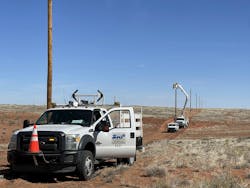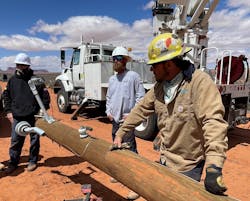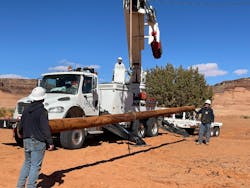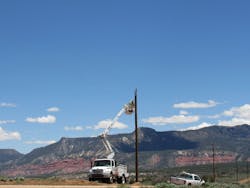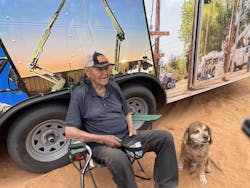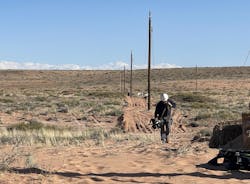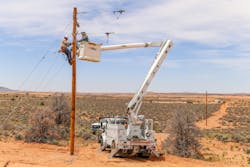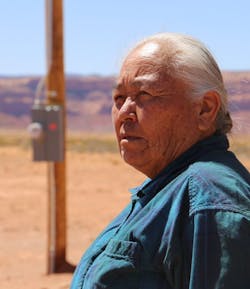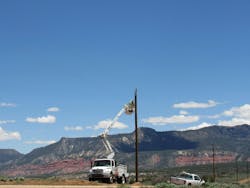Mutual Aid Without a Storm: The Light Up Navajo Project
When the lights go out in communities nationwide, crews join forces to rebuild infrastructure and restore power. Through the Light Up Navajo project, volunteer lineworkers provide mutual assistance — but without a storm.
The humanitarian project, which launched in 2019, brings the line trade together to illuminate the 13,500 homes without electricity on Navajo Nation. About 75% of all U.S. households without power live in this 27,000-square-mile region, which spans parts of Arizona, New Mexico and Utah, has 300,000 residents and a total of 55,000 homes.
In 2022, 69 lineworkers from 14 utilities in 10 states volunteered to provide electricity to 137 homes on the Navajo Nation, reducing the cost to connect each home by 25%, said Walter (Wally) Haase, the general manager of the Navajo Tribal Utility Authority (NTUA). This year, lineworkers from 26 public power utilities in 16 states volunteered for the project, including Dean Frescholtz, journeyman lineworker and section supervisor for Salt River Project (SRP), a member of the American Public Power Association (APPA).
After spending 23 years in the line trade, Frescholtz said he’ll never forget when the homeowners saw the lightbulbs glow for the first time in their homes. “They were very excited to have power, and it made me feel great,” he said. “It felt like a humanitarian effort in our own backyard. I didn’t even realize before I had volunteered to do this that there were people living in the state of Arizona in 2023 who did not have electricity.”
Jeff Haas, the acting president and CEO and senior vice president of membership and education for APPA, said many APPA members aren’t aware that 30% of the Navajo people don’t have electricity or running water. The NTUA is a public power enterprise, and when APPA communicates the need for assistance, their members are answering the call for help. “The beautiful thing about public power is that it’s community-driven to its core,” Haas said. “So, when we communicate the need, we find there are many willing parties to volunteer to take their line crews, equipment and materials across the entire country to the Navajo Nation to provide support.”
One of the common misconceptions about the Navajo people is that they do not want their homes wired for electricity and connected to the grid, he said. Haas recently visited the Navajo Nation to observe the volunteer line crews in action and talk to the Navajo families and said that’s simply not the case. Many of the homeowners on Navajo Nation have been waiting years to get access to electricity. Traditionally, if a home is not one mile from a connected circuit, it can take a long time to go through the federal permit process and a commitment from the utility to extend the electricity beyond that one mile.
“I think we need to get better and need federal support to reduce the time it takes for the permitting process,” he said. “It’s the Navajo people’s land, and they want this service, and they deserve this essential service. How can their children access broadband, do their homework effectively and learn and thrive without such an essential service as electricity and running water? We, as a country, can do more, without a doubt.”
Coming Together
Four years ago, APPA partnered with the NTUA to expedite rural electrification on Navajo Nation. At that time, Haase of the NTUA was serving as the APPA board chair, and he started to bring attention to the plight of the Navajo people. When he traveled around the country to speak at conferences, Haase remembers the audience members’ shock that so many Americans were without essential services and the majority were living on the Navajo Nation. “They were all under the impression that it was more of a Third World country problem, and they couldn’t believe that there was that large of a population in the United States that didn’t have access to these facilities,” he said.
Over time, the interest in the electrification of the Navajo homes escalated, and more people started asking questions about the role of the federal government in the issue and how they could help. “Many of my fellow APPA members and other members came up to me and said, you know, this is really wrong,” Haase said. “Our communities solved the problems 100 years ago or more, and the co-ops solved the problems in the 1920s, 1940s and 1950s. They felt compelled to say this is an injustice, and it’s a moral issue.”
At that point in time, 15,000 homes on Navajo Nation had no electricity or running water. To shorten the timeline for the Navajo families to get service, Haase partnered with the NTUA and APPA to launch Light Up Navajo. The project is not only allowing lineworkers to help their fellow Americans but also gain a new set of skills in the line trade. Back in their home service territories, the systems may be completely built out or the power lines are mostly buried underground. On the Navajo Nation, however, the volunteer line crews have a valuable training opportunity, Haase said.
The Navajo Nation line crews also perform distribution work and work in challenging conditions, which prepares them for storm response. Volunteers string wire, install poles, set transformers and install meters on a distribution system from start to finish — all while working with knowledgeable peers, learning best practices and gaining experience.
“When you get called out on mutual aid, you’re going to be working in areas where there is a natural disaster — tornadoes, windstorms, hurricanes or freezing rain — that brings down lines,” Haas said. “Working on the Navajo Nation gives line crews an opportunity to really test their mettle in a situation where the lines aren’t energized.”
This valuable opportunity to train line crews is often a motivating factor and a justification for APPA’s member utilities to send crews to the Navajo Nation. It also allows the lineworkers to create a network within the trade. “Lineworkers are a very tight-knit community,” he said. “To see these individuals working literally arm in arm for a purpose as noble as bringing electricity and essential service to the Navajo people is one of the most rewarding work-related and personal experiences I’ve had in my lifetime.”
Expediting Electrification
Before the launch of the Light Up Navajo initiative, the NTUA relied on state and federal funding to extend electricity on an annual basis to Navajo homes while maintaining its own vast distribution system. The Navajo Nation, however, is the size of West Virginia, and it has rugged terrain, slowing the rural electrification. In 2018, Demonstration of Energy and Efficiency Developments, a research and development program, funded an analysis of what it would take to get line crews from across APPA’s membership to participate in efforts to bring electricity to Navajo homes.
“We looked at how to create efficiencies and apply best practices as it relates to the creation of the distribution system on the Navajo Nation and use APPA’s resources,” Haas said.
For the pilot project in 2019, lineworkers from 12 states and 25 utilities connected 233 homes to electricity in six weeks, reducing the total number of U.S. homes without electricity by 1%. “We learned very quickly that there was some inertia, and that the utilities that participated got a lot out of it,” Haas said.
The next year, dozens of utilities signed up to participate in Light Up Navajo II, but the volunteer mission was canceled due to the COVID-19 pandemic. That didn’t stop the NTUA, however, which was able to leverage the Coronavirus Aid, Relief, and Economic Security Act to extend electricity to several hundred homes that year.
The following year, the APPA brought volunteers back on Navajo Nation, and for 2023, the open volunteer slots filled up quickly for Light Up Navajo IV, which started in April 2023 and was extended from June to July to accommodate the number of available line crews.
Going Above and Beyond
The line crews who volunteer for Light Up Navajo are paired with NTUA foremen who know the system, the local Navajo language and how to navigate the desert landscape and mountainous terrain. “They work in tandem with NTUA line crews, so there are limitations as to how many crews can be sent at any one time,” Haas said. “Having someone who knows where they’re going and how the system operates is important.”
The lineworkers often work 12-hour days, but they are proud and extremely happy to be volunteering their time, Haas said. Case in point: One of the line crews worked well past 9 p.m., and by the time they got back to their motel, none of the restaurants or food service facilities were open. “They worked so long that they missed their dinner,” he said. “The sense of purpose is extremely strong on this project.”
Because the Navajo Nation encompasses such a large region, the NTUA dispatches the volunteer crews to different districts to work in the small communities. That way, they can focus on electrifying a certain portion rather than overlapping during the multi-week project. “We have four crews at a time, because we need to balance our workforce, our materials and our own equipment,” Haase said.
Listen to an interview with Dean Frescholtz, Light Up Navajo volunteer, journeyman lineworker and section supervisor for Salt River Project, for the August 2023 Line Life Podcast episode.
During one Light Up Navajo project, however, the NTUA scheduled five crews to come in, and three of the crews from the previous week called their bosses back home and asked to stay an extra week to get their work done. They received permission to continue volunteering, and as a result, eight crews were on site simultaneously.
“That’s quite an endeavor to manage all that manpower, materials and equipment, but it’s a fantastic story where they just felt in their body, heart and mind that they didn’t want to leave,” Haase said. “They wanted to finish helping their community members get power for the first time.”
Haas said public power utilities of all sizes have sent line crew volunteers to the Navajo Nation, but they all have one thing in common — they know it’s the right thing to do. “They have to juggle their interests at home because there are limitations locally with regards to local assets, lineworkers, materials and equipment,” he said. “Sending a truck or line crew across the country may be difficult, but we are finding that our members are really good about figuring out how to get it done.”
Constructing Lines
Like mutual aid following a storm, the project organizers sent line crews to different regions to perform line work. The crews stayed in local hotels, sometimes an hour or more from the work sites, and the NTUA provided lunch to the volunteers.
Frescholtz said during the volunteer project, he worked with lineworkers from SRP’s distribution line maintenance department. SRP sent 14 employees including a supervisor, working foreman, lineworkers, an operator and a mechanic to the Navajo Nation in 2023.
The lineworkers construct power lines to homes that have already been wired for electricity by the NTUA and its outside contractors. The homeowners must first file a request for electrification, and then once their home is ready to accept electricity, the volunteer line crews travel to their location to build a power line and set up a meter to get the power flowing.
In his day-to-day job, Frescholtz supervises crews on distribution pole replacement projects, but on the Light Up Navajo volunteer project, he was installing poles and stringing lines to provide first-time power for the Navajo Nation. “There’s no storm that knocked all the poles down that we’re going to put back up,” he said. “It’s mutual assistance because other utilities are coming to help to build power lines for the first time.”
Over the course of three weeks, his team of volunteers built six miles of power line, set 104 poles and strung more than 63,000 ft of wire. Last year, when the SRP crews volunteered for the project, they energized a few homes in one day, but this year, they brought electricity to 10 homes. He said that it was more remote than last year’s volunteer project.
Frescholtz said he enjoyed the work because it was much different than what he’s used to in Arizona. In his service territory, his crews often work in congested metropolitan areas, where they must contend with lane closures and traffic control plans. “Light Up Navajo was really nice because it was in the wide-open countryside on dirt roads,” he said. “It was nice to just go out there and get back to the grassroots of building a straight power line without running angles or installing buck arms and three pot banks.”
One challenge the crews faced, however, was working in difficult terrain. To overcome this obstacle, the crews used a bulldozer to pull line trucks with trailers.
Frescholtz said his team learned lessons from their first year on the volunteer project. This time, they only took six by six trucks, which are four-wheel drive boom and bucket trucks. They also brought a hole digger, wire trailer, and pole trailer to transport materials.
"We have very few trucks at SRP that are actually four-wheel drive because we work in the city most of the time," he says. "But all the trucks we took up there had four-wheel drive applications, he said. We knew we were going to have some difficult conditions, and they did quite well up there."
While constructing about 40 of the poles, however, the trucks couldn't navigate the sandy terrain. To help the SRP crews, the NTUA supplied a bulldozer so the lineworkers could hook pulling ropes from their trucks and move them through the sand with pulling trailers.
Beyond the access issue, lineworkers were also challenged by the weather conditions.
"Working in Phoenix, Arizona, we're used to heat--that's what we deal with on a day-to-day basis, he said. "But up on Navajo Nation, there's more of a four-season atmosphere up there. A few of the days, the lows were in the 20s, and the high was 30 degrees. We're not used to working in cold temperatures like that."
The chill combined with strong winds provided a unique work environment for the Arizona crews.The SRP team traveled about three-and-a-half hours north of the service territory for the volunteer project.
"The weather changes quite rapidly, and when you're out in 28-degree temperatures and the wind is blowing 50 miles per hour, it adds a wind chill that we're not used to," he said.
Haas agreed, saying while the landscape is beautiful, the terrain and weather conditions can be inhospitable at times. "Even when I was there in April, there were wind storms that made it very difficult to see a few feet in front of you," he said.
Providing First-Time Electricity
During the Light Up Navajo project, Freshholtz said his favorite memory was just being with the people, both those who live on the Navajo Nation as well as the other volunteer line crews.
"I not only got to work with journeyman linemen from Utah, but also people who work for other utilities," he said. "We were able to work side by side with them and their supervisors and managers.
Frescholtz also had the opportunity to interact with the community members and help illuminate their homes for the first time, which was life-changing for them and their families.
"A good percentage of them were at home when we were able to plug in the meter and turn on the lights for the first time," he said.
This time around, his team remembered to bring a very important item with them--cases of light bulbs. That way, after the lineworkers built the power line and set the meter, they could screw in the bulbs and demonstrate the glow of electricity.
Before their homes were wired for electricity, the homes were illuminated by generators or kerosene lamps. Without access to electricity, the households faced other challenges. Navajo families didn't have access to running water, modern forms of heating or cooling or appliances like refrigerators and microwaves, according to APPA. Every week, they had to drive one to one-and-a-half hours to watering spots. Just to fill 250-gallon plastic tanks with water for drinking, cleaning, and cooking, without the ability to use modern appliances like refrigerators, they had to fill coolers with ice to keep their food from perishing.
“You can imagine, if you are living on the Nation, at times you could be from 45 minutes to an hour from the nearest point to get groceries,” Haas said. “Then you have to bring them back to your home and essentially pack anything that’s perishable in ice, and it will last anywhere from two to four days. I’ve also heard stories of families either renting refrigerators or keeping a refrigerator of their own at a relative’s house that in some instances was 40 minutes away one way.”
Family members have ended up leaving Navajo Nation due to the lack of access to essential services, but the electrification of the homes allows them to return once again. “They now have essential services they need to raise a family and to thrive,” he said. “They’ll join the generations of their family that live in these homesteads.”
The program not only gives the Navajo families a better life, but it also helps to create trust and bonds between the community members and the volunteer line crews, Haase said.
“This allows a very diverse group of Americans to gain respect for each other,” he said. “Anytime you can help one family to have a better life and give them the opportunity to become part of society and be productive, you’re helping all of society. It’s a tremendously positive experience for everyone, and that’s the thing that makes this program so great.”
Planning for Future Growth
Through the Light Up Navajo project, utilities are also working together to continue to provide electrification to the homes on Navajo Nation. Frescholtz said that SRP’s goal is to continue supporting the project. “There are no plans in the future for this to stop,” he said. “Every year, we’ll continue to put out the request for volunteers, and we’ll load up with the same or different personnel to go back up there.”
JD Munoz, a working foreman for SRP, said the Navajo families are very grateful for the work of the volunteer line crews. “It’s humbling and gratifying to bring these folks electricity for the first time,” Munoz said. “To provide power to someone who has never had it is a good feeling. This is my first time working on Light Up Navajo and it won’t be my last.”
Haas said APPA is committed to continuing the Light Up Navajo project until all the homes requiring electricity have been energized. “These people have, in some instances, literally waited generations — in some cases more than 50 years — to get electricity, and we want to accelerate the number of homes that are connected on an annual basis. We need to do better.”
Haase said when he first started at NTUA 16 years ago, about 18,000 families didn’t have electricity, and thanks to the efforts of the volunteer line crews, that number dropped to about 13,500, which is about 52,000 U.S. citizens.
“At the pace we were going by ourselves 50 years from now, we would still have United States citizens without electricity and running water and still using outhouses,” he said. “Through the additional efforts of the Biden administration and others, we’ve cut that down from 50 years to 30 years. It’s a significant reduction if we keep going at this pace.”
Currently, the project’s ultimate goal is to try to get to about 500 families a year, which hits the 30-year pace. From there, the project organizers hope to provide power to 1,000 families annually, which will increase it to a 15- or 20-year pace, Haase said. The NTUA is looking to expand programs and dollars to speed electrification and lessen the time families need to wait for essential services. “Even if I get to 1,000 families a year, it’s a difficult task to tell someone that it’s 15 or 20 years to get connected, but it’s better than 50 years,” he said. “This is a big problem, but you have to be happy with taking small victories and moving the ball forward to help more and more people.”
Haase would love to have the Light Up Navajo project finished in his career, or at least in his lifetime, but that’s going to take more outside help with materials and equipment. “So far, more than 600 families or more than 2,000 United States citizens got electricity for the first time. That’s positive for all our partners to recognize, but it also drives them to say how can we help to improve this and get it done faster.”
Over the years, not only public power utilities but also investor-owned utilities and electric cooperatives, have sent volunteer line crews to the Navajo Nation to provide assistance. In the future, Haase said he would like to see more cooperatives and investor-owned utilities join the municipal-owned utilities to expand the program. For 2023, the program length has also been extended a few extra weeks, which he said is a step in the right direction. As of June 25, 2023, the volunteer line crews built more than 40 miles of line and connected 131 families.
In 2021, the NTUA also added a new program — Mutual Aid Training — which further expands the mission of Light Up Navajo. The six-week training initiative, which takes place in the fall rather than the spring and summer, focuses on projects with longer lines and involves not only lineworkers, but also electricians. In 2021, the Los Angeles Department of Water & Power (LADWP) helped the NTUA connect 80 homes, and last year, the lineworkers connected 62 homes.
“Having the opportunity to see firsthand what it’s like in a part of America in 2023 without an essential service really did impact me in a profound way,” Haas said. “I think many other Americans may be shocked — I may use the word, appalled — to see how our fellow proud Americans have been treated. We need to do more. I think it’s our duty as Americans to take care of our own, and for public power’s part, we’re going to ensure that we continue to do that.”
Amy Fischbach ([email protected]) is the Field Editor for T&D World magazine.
T&D World's Line Life Podcast shined the spotlight on the Light Up Navajo project by featuring an interview with Volunteer Dean Frescholtz, section supervisor for Salt River Project. Listen here.
Volunteer Lineworkers Share Their Stories
This video from the NTUA showcases volunteer lineworkers and their experiences working on the Navajo Nation. For many lineworkers, it was a life-changing experience to give the Navajo people the opportunity to have first-time electricity.
Light Up Navajo: How to Help
1. Send a volunteer line crew. While the program is not yet set up to accept individual lineworker volunteers, APPA member companies or interested utilities can fill out an inquiry form on NTUA’s website at www.ntua.com/light-up-navajo.
2. Donate to the cause. To prepare a home for electrification, it costs about $8,000 to wire a home and another $2,000 to install a meter and socket. Extending electricity to a single home runs about $40,000. While these costs can be brought down through the deed grant and certain efficiencies, financial resources are still in need. Utilities can make a tax-deductible donation of $5,500 to sponsor the electrification of one home or $27,000 to power up to five homes. For more information, email Deenise Becenti, NTUA government/public affairs manager at [email protected].
3. Give materials. Constructing the power lines to each of the homes on Navajo Nation requires equipment and materials. If your utility has resources to donate to the cause, email the NTUA.
4. Sign up for the fall 2023 mutual aid training program. The NTUA is looking for a utility to send both electrician and lineworker volunteers for the fall 2023 program on the Navajo Nation.
Step by Step: Electrifying Homes on Navajo Nation
Before the volunteer line crews even step foot on Navajo Nation, a lot of work has already been done to set up the homes for electrification. Here’s a glimpse at the process.
1. An NTUA customer fills out an application to be part of the program. The applications are taken on a first-come, first-serve basis, says Walter Haase, general manager of NTUA.
2. The NTUA creates a design for the line and figures out how to connect it to the electrical system.
3. The federal government owns the land on Navajo Nation, so the NTUA must secure right-of-way (ROW) permission. Haase estimated that it would take about $13,000 to complete the paperwork and use the land to get the ROW for each home.
4. The utility hires outside experts to perform environmental, biological and zoological surveys of the project site. If the power line will be less than a mile long, it takes six to nine months, but if it’s more than a mile, it can take a year and a half. This process can take even longer if the experts discover a cultural artifact, rare plant or protected animal species.
5. Using grant funds, the NTUA hires an outside contractor to install the 200A service to the home.
6. The field workforce for the NTUA an outside contractor installs the meter pole and socket.
7. The NTUA inspects the inside wiring of the home.
8. The staff orders the bill of materials and has it available for the crews coming out to volunteer for Light Up Navajo.
9. The line crews arrive on Navajo Nation to perform the line work for anywhere from one to three weeks at a time.
10. After the line has been energized, the lineworkers experience the joy of the homeowners when their lights come on in their homes for the first time.
Week in the Life of a Volunteer Line Crew on Navajo Nation
Line crews from across America have volunteered for the Light Up Navajo project. After they fly to the area or arrive after a multi-day drive, they travel to the designated location using their vehicles or rental trucks from the NTUA. Here’s a look at what a typical week looks like for a line crew on the Navajo Nation.
Saturday or Sunday: The crews attend a three- or four-hour orientation program, which covers an introduction to the program and cultural sensitivity and awareness. A large focus of the training is on safety because not all utility companies have the same construction standards, says Walter Haase, general manager of NTUA.
Next, the crews are dispatched to different areas on the Navajo Nation and teamed up with a foreman from NTUA. They also travel to one of the yards to see a mockup of how things are built, and if possible, they start a job to help get as many families connected as possible during their stay.
Monday and Tuesday. The crews meet at 7 a.m. at the district office to load the material. They then drive about an hour or more to focus on short-line extensions, which are single-family homes less than a mile from the existing distribution line. About two or three families are often connected at one time.
Wednesday. To give the crews maximum time in the field, the NTUA stages the material and brings it out to the work site. Lineworkers then work on community power line projects and build miles and miles of single-phase line and then connect customers off that line. Haase says this is the best training exercise for the crews, but the connection of the individual family members is equally important. “We try to make sure that every crew that comes out has experience in doing that,” he says.
Thursday. The line crews stop work early and enjoy an appreciation dinner in the local community that has gotten connected. Navajo family members are invited to talk to the outside crews about what the program means to them and how it has helped them.
Friday. The crew resumes work.
Saturday and Sunday. If the crew plans to stay two weeks in a row, they will also work all day Saturday, a partial day on Sunday, and then continue working on big projects for the rest of the following week to connect as many families as possible.
Voices from the Field
Before the line crews embark on their volunteer efforts on the Navajo Nation, they attend an onboarding session in which they learn about the importance of the project and watch a video featuring past volunteer lineworkers. The following are just a few of the many memories from the visiting crew members who volunteered their time and talents to Light Up Navajo.
-
“To be honest, I didn’t realize that people still lived without power for such a long period of time,” says Joe Sanchez of Sacramento Municipal Utility District. “It was pretty humbling and made me appreciate what I have back home as well and made me appreciate the work that we did out here.”
-
"It’s nice to have a trade where you can give back and actually help people who have not had the things they need,” says Edward Kimble from the City of Hamilton, Ohio. “They really do need it. I hope each and every one gets their electric like they deserve.”
- “It makes me feel prideful about my country and my job, just being out here helping and doing something that will change people’s lives,” says Carson Kaltenbaugh of American Municipal Power (AMP) in Ohio. “It adds to my pride of what I do. I’m grateful that I was able to come out and be part of the experience.”
- “We hooked up some people who said they had been without power for eight years where they were at, and they had six children in the house,” says Bobby Lewis, Greenville Utilities Commission, South Carolina. “When we were done hooking them up, they all came out and gave us hugs and told us how grateful they were to have power. It was just an awesome experience.”
About the Author
Amy Fischbach
Electric Utilities Operations
Amy Fischbach is the Field Editor for T&D World magazine and manages the Electric Utility Operations section. She is the host of the Line Life Podcast, which celebrates the grit, courage and inspirational teamwork of the line trade. She also works on the annual Lineworker Supplement and the Vegetation Management Supplement as well as the Lineman Life and Lineman's Rodeo News enewsletters. Amy also covers events such as the Trees & Utilities conference and the International Lineman's Rodeo. She is the past president of the ASBPE Educational Foundation and ASBPE and earned her bachelor's and master's degrees in journalism from Kansas State University. She can be reached at [email protected].
